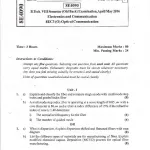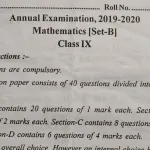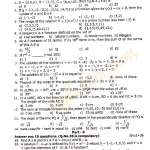Questions and Answers for Social Studies:
-
What is the importance of agriculture in India?
Agriculture plays a crucial role in the economy of India. It provides employment to a large number of people and contributes significantly to the country’s GDP. It is also essential for producing food and raw materials for industries. -
Describe the main features of the Indian constitution.
The Indian constitution is the supreme law of India, consisting of a preamble, articles, and schedules. It establishes India as a democratic republic, guarantees fundamental rights, and defines the powers of the government. -
Explain the role of the government in protecting the environment.
The government plays a vital role in protecting the environment by implementing policies, creating awareness, enforcing laws for pollution control, and promoting conservation of natural resources. -
What is the difference between renewable and non-renewable resources?
Renewable resources are those that can be replenished naturally, such as solar energy and wind. Non-renewable resources, like coal and petroleum, are finite and cannot be replaced once used up. -
Who was Mahatma Gandhi, and why is he important in Indian history?
Mahatma Gandhi was a leader of the Indian independence movement. He is famous for promoting non-violent civil disobedience and played a key role in India’s struggle for freedom from British rule. -
What is the significance of the Himalayas in India?
The Himalayas are important as they protect the Indian subcontinent from cold winds from the north, influence the climate, and are a source of rivers. They also offer rich biodiversity and are culturally significant. -
What is the capital of India?
New Delhi is the capital of India. It serves as the seat of the Indian government and is an important cultural, political, and historical hub. -
Define democracy and explain how it works in India.
Democracy is a system of government where the people elect representatives to make decisions on their behalf. In India, citizens vote in elections to choose members of parliament and state assemblies. -
What are the primary seasons in India?
India experiences three major seasons: summer, monsoon, and winter. The summer season is hot, the monsoon season brings rainfall, and winter is cool and dry. -
Explain the concept of secularism in India.
Secularism in India means that the state does not favor any religion. All religions are treated equally, and people are free to practice any religion of their choice. -
What is the role of rivers in India’s economy?
Rivers are essential for irrigation, transportation, and provide water for drinking and industrial use. They also play a vital role in agriculture, which is a major part of India’s economy. -
How does the Indian government promote education?
The Indian government promotes education through various initiatives like the Right to Education Act, providing free education to children between the ages of 6 and 14, and setting up educational institutions across the country. -
Discuss the importance of forests in India.
Forests are vital as they support wildlife, help in the water cycle, provide timber, and prevent soil erosion. They also help in maintaining biodiversity and provide raw materials for industries. -
What is a national park, and name one in India?
A national park is a protected area reserved for wildlife conservation and tourism. One example of a national park in India is Jim Corbett National Park, located in Uttarakhand. -
How does agriculture impact the Indian economy?
Agriculture is the backbone of India’s economy, providing livelihood to millions of people and contributing to food security. It also supplies raw materials for industries and supports rural development. -
Explain the significance of the Indian independence movement.
The Indian independence movement was a struggle against British colonial rule, led by figures like Mahatma Gandhi. It ultimately led to India gaining independence on August 15, 1947. -
What are the different types of landforms found in India?
India has a variety of landforms, including mountains (Himalayas), plateaus (Deccan Plateau), plains (Indo-Gangetic Plains), and deserts (Thar Desert). -
What is the role of women in Indian society?
Women in India play diverse roles as homemakers, professionals, and leaders. Though historically facing challenges, women have made significant progress in education, politics, and business. -
What is the importance of the Panchayati Raj system?
The Panchayati Raj system is a decentralized form of governance at the village, intermediate, and district levels. It promotes local self-governance and allows for the active participation of rural people in decision-making. -
Describe the Indian flag and its symbolism.
The Indian flag has three colors: saffron (representing courage), white (truth and peace), and green (fertility). It also has a blue Ashoka Chakra symbolizing the wheel of law and progress.
Recommended Books for 6th Class Social Studies – 2019 SA2 Preparation
-
Social Science for Class 6 by R.S. Aggarwal, S. Chand Publications
This book covers a wide range of topics in history, geography, and civics. It includes chapters on early human history, the physical features of India, the Indian Constitution, and more. The questions include fill-in-the-blanks, true or false, multiple-choice, and short-answer questions, focusing on conceptual understanding. -
India’s Struggle for Independence by Bipan Chandra, Orient BlackSwan
This book covers the history of India’s independence movement. The content revolves around key events, movements, and figures in Indian history. Questions typically include essay-type questions, analyzing important historical events and their impacts. -
Our Past – 1 (History) by NCERT, NCERT Publications
A comprehensive book for understanding the ancient history of India. It includes chapters on early civilizations, the Maurya and Gupta empires, and the developments of art and culture. The book features descriptive questions, matching-type questions, and map-based queries. -
Social Studies (History, Civics, Geography) by A.K. Sharma, Laxmi Publications
This book provides a detailed understanding of the three main subjects of social studies. Questions are well-balanced, including definitions, short essays, and map work that reflect the syllabus for class 6. -
Geography – India and the World by T. Jeyaraj, Saraswati House
This book focuses on the geographical aspects of India and the world, including climate, natural resources, and human activities. Expect questions on map identification, short-answer questions on the geography of India, and long-answer questions related to environmental issues. -
Together With Social Science – Class 6 by Dr. S. S. S. Kumar, Rachna Sagar
A supplementary workbook for social studies. This book contains a variety of questions, including multiple-choice, match the following, and short-answer questions. It focuses on building skills like map-reading, understanding geographical concepts, and historical timelines. -
Indian History for Kids by Malathi Iyengar, NBT India
This book offers a kid-friendly explanation of Indian history, focusing on the major dynasties and historical events. The book includes simple comprehension questions, activity-based tasks, and critical thinking questions that encourage young readers to explore history creatively. -
Civics for Class 6 by K.K. Choudhury, Vikas Publications
This book deals with topics like democracy, the Indian constitution, and the role of government. It provides insightful questions about the structure of the government, rights and duties, and social justice. Expect questions like describing government structures, explaining the significance of rights, and application-based questions. -
Science and Social Studies (Class 6) by P.K. Gupta, S. Chand Publications
This book integrates social studies with science concepts, especially focusing on how human activities impact the environment. It includes concept-building exercises, map labeling, and short-answer questions, aiming to help students connect social issues with environmental awareness. -
Bharatiya Itihas (Indian History) by R. R. Sharma, National Book Trust
A detailed and easy-to-understand book on Indian history, covering significant events from the ancient period to the medieval period. The questions mainly focus on explaining historical events, and the significance of rulers, and include map-based questions. -
Geography: Our World and Beyond by Pratibha Shukla, Pearson India
This book helps students understand the geographical divisions of the world and India. The types of questions focus on the physical features of the earth, climate zones, and human settlements. It includes map-related questions and questions about physical features like mountains, rivers, and deserts. -
Civics: Understanding Society by D.K. Rai, Orient BlackSwan
Focusing on the societal and governmental systems, this book covers the constitution, democracy, and governance. The content includes questions on the functioning of local governance systems, the importance of laws, and short essay questions on social responsibilities. -
My Social Studies – 6 by Dr. B.B. Kumar, Prakash Publications
A comprehensive book with easy-to-understand content on history, geography, and civics. The book includes a wide range of questions, including true/false, fill-in-the-blanks, and long-answer questions that test your grasp of social issues, historical knowledge, and geographical awareness. -
Social Science Class 6 by M. S. Shankar, Bluebird Publishers
This book provides a detailed breakdown of social science concepts like the importance of rivers, culture, and ancient Indian kingdoms. Questions include descriptions of the social structure in ancient India, identifying cultural heritage, and summarizing key historical events. -
The Story of India by John Keay, HarperCollins
A narrative approach to Indian history, this book presents the history of India from the ancient to modern times. The book encourages students to reflect on the development of culture, politics, and society through essay questions and creative activities that focus on historical interpretation. -
Our Social Studies Book by R.B. Pandey, Ramesh Publishing House
This book offers concise explanations of various social science topics, making it a useful resource for short-answer questions and case studies. The questions are designed to encourage students to analyze, discuss, and apply the concepts in real-world situations. -
Vishva Bhugol (World Geography) by K.K. Jain, NCERT
A book specifically focused on world geography, it explores continents, countries, oceans, and the physical features of the earth. Questions typically include map identification, climate-related questions, and human-environment interaction. -
Indian Government and Politics by Sandeep Singh, Academic Publications
This book focuses on understanding the democratic system and structure of the Indian government. It provides questions related to governance, roles of politicians, and the functioning of government departments at various levels. -
History of India (Class 6) by K.K. Verma, Navneet Publications
A well-structured book that guides students through early Indian civilizations and the rise of kingdoms. The content includes questions related to early civilizations, the impact of various empires, and the historical importance of ancient Indian monuments. -
A History of India for Children by Subhadra Sen Gupta, Puffin Books
This book simplifies Indian history for younger audiences, focusing on stories from India’s past in a narrative style. Questions in this book often require students to summarize historical events, compare past and present scenarios, and express personal reflections on historical figures.
6th Class Social Question Paper 2019 SA2: A Comprehensive Guide for Students
The 6th Class Social Question Paper 2019 SA2 is a critical assessment for young students aiming to excel in their academic journey. This paper primarily focuses on testing the understanding of social studies, which is divided into subjects like history, geography, and civics. It evaluates students’ grasp on various important concepts, from ancient history to the structure of government. For students, it is essential to approach this paper with the right preparation and strategy to achieve optimal results.
Social studies can often be overwhelming, especially with its vast range of topics. However, with proper planning, students can break down each section, focusing on key themes and essential facts. For history, understanding ancient civilizations, the rise of dynasties, and the struggle for independence is crucial. Geography questions usually revolve around India’s physical features, climate zones, and map-related queries. Civics, on the other hand, assesses students’ knowledge of the Constitution, the government structure, and social responsibilities.
One of the best ways to tackle the social question paper is to focus on conceptual clarity. For history, ensure that you are familiar with the significant events and figures, as these are often asked in short-answer or long-answer formats. For geography, focus on understanding physical maps, rivers, mountains, and their impact on daily life. Civics questions generally focus on the roles and responsibilities of citizens, and understanding government institutions can significantly improve your performance.
Effective Study Strategies for 6th Class Social Studies
Start by organizing your syllabus and break down each subject into smaller, manageable parts. For history, make sure to focus on key historical periods like the Indus Valley Civilization, the Mauryan and Gupta empires, and the independence movement. These topics are frequently highlighted in the question paper. For geography, ensure that you understand India’s map thoroughly, including major rivers, mountain ranges, and deserts. Civics requires understanding the democratic process and the roles of the government at different levels.
Also, practicing sample papers and previous year’s question papers is a valuable strategy. This not only helps you become familiar with the question format but also builds time management skills. By regularly revising and practicing, you can reinforce your learning and increase your chances of doing well in the exam.
The 6th Class Social Question Paper 2019 SA2 is designed to test both knowledge and application. Hence, students should focus not just on memorizing facts but also on understanding the concepts deeply. This approach will allow you to answer questions more effectively, demonstrating not just rote knowledge but also analytical skills.
FAQ for 6th Class Social Question Paper 2019 SA2
-
What subjects are covered in the 6th Class Social Question Paper 2019 SA2?
The paper covers three main subjects: history, geography, and civics. Students are expected to have a solid understanding of these topics and be able to apply their knowledge to answer various types of questions. -
What types of questions can I expect in the social question paper?
You will face a variety of questions, including multiple-choice questions, short-answer questions, and long-answer questions. There may also be map-based questions and questions that test your understanding of concepts like democracy, geography, and history. -
How can I prepare effectively for the social studies exam?
To prepare effectively, start by reviewing your textbooks and study materials. Break down each chapter into key concepts and facts. Practice sample papers and previous year’s question papers. Revising regularly and understanding concepts rather than memorizing them is key to performing well. -
Are map-based questions common in the social studies exam?
Yes, map-based questions are a common feature in geography sections. These questions typically require you to identify and label physical features such as rivers, mountains, or states on a map. It’s important to be well-versed with the Indian map and global geography. -
How much time should I allocate to each subject while studying?
Allocate study time based on the difficulty and length of each subject. History and geography might take more time as they involve memorizing key dates, events, and locations, while civics focuses on understanding concepts like governance and citizen responsibilities. -
What can I do to avoid common mistakes during the exam?
One common mistake is rushing through the paper. Read each question carefully, understand what’s being asked, and then write your answers. Ensure your handwriting is legible and answers are concise and to the point. -
Is it necessary to learn all the chapters in the textbook?
While it’s advisable to cover all chapters, focus on the core topics mentioned in your syllabus. Prioritize chapters that are frequently tested and ensure that you have a solid understanding of the key concepts. -
How can I improve my civics knowledge for the exam?
To improve civics knowledge, focus on understanding the Constitution, the role of the government, and the rights and duties of citizens. Read through case studies and examples to apply the concepts in real-life situations. -
What are the most important topics in geography for the exam?
The most important geography topics include India’s physical features, climate, natural resources, and map-based questions. Make sure to understand key geographical concepts and practice reading maps regularly. -
How can I manage my time during the exam?
Time management is crucial in the exam. Allocate specific time for each section based on the marks assigned to them. Start with the questions you know best to build confidence, and ensure you leave enough time to review your answers before submitting your paper.
Latest Posts
- Step-by-step guide to download and apply for jee mains admit card 202
- Comprehensive 2025 government holidays and recruitment details for job seekers
- JEE Mains Admit Card 2025: Your Step-by-Step Guide to Downloading the Hall Ticket
- Everything You Need to Know About 2025 Government Holidays Recruitment
- Comprehensive Guide to rrb d group recruitment 2025 – Eligibility, Vacancies, and Application
- Detailed guide to nps trust recruitment 2025 vacancies, eligibility and apply process
- Comprehensive guide to hpcl recruitment 2025 notification, vacancies, and application process
- ignou bed admission 2025 complete recruitment guide with eligibility and process
- Comprehensive Guide to Indian Army Agniveer Recruitment 2025 Notification and Jobs
- Everything You Must Know About CBSE Board Exams 2025 Changes & New Rules






